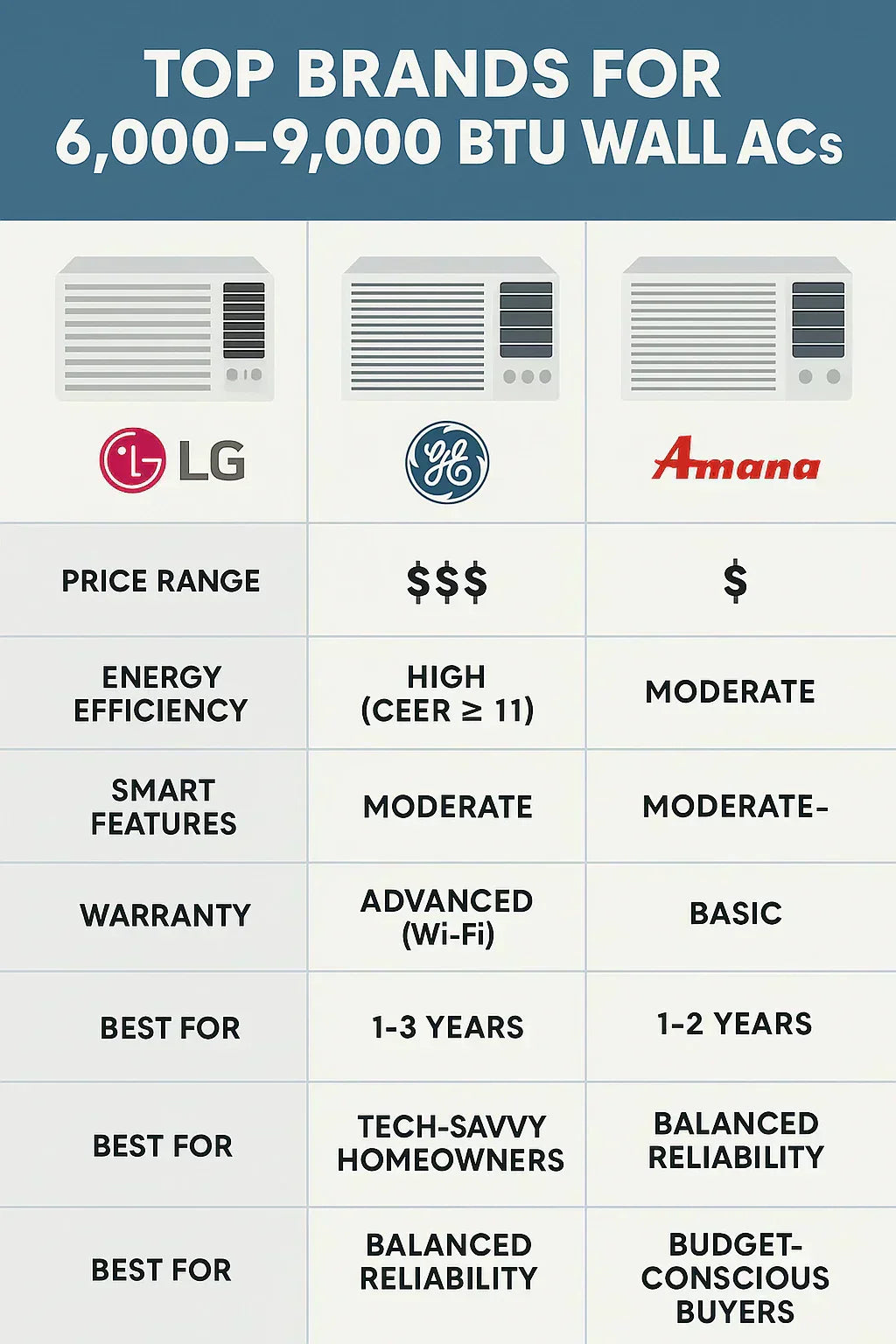🌬 Introduction
Jake’s old wall AC had seen better days. It rattled, leaked, and drove up his summer energy bills. This year, he’s determined to upgrade to a 6,000–9,000 BTU through‑the‑wall AC that balances efficiency, comfort, and cost.
Like many homeowners, Jake narrowed his choices to three reliable brands: LG, GE, and Amana. But which one should he buy?
This guide takes you through:
-
Why the 6k–9k BTU range is so popular
-
Key features of each brand
-
Pros, cons, and real‑world performance
-
Cost comparisons
-
Jake’s tips for making the right decision
📏 Why the 6,000–9,000 BTU Range Is So Popular
Before diving into brands, Jake asked himself: Am I sure 6k–9k BTUs is right for my space?
✅ Ideal Room Coverage
-
6,000 BTU: 150–250 sq ft (bedrooms, home offices).
-
8,000 BTU: 250–350 sq ft (living rooms, small dens).
-
9,000 BTU: 350–400 sq ft (larger bedrooms, open apartments).
📌 Reference: PickHVAC BTU to Room Size Chart.
⚡ Energy Use
-
Typical power draw: 600–900 watts.
-
Works with standard 115V outlets (most models).
-
Easier for DIY installation compared to larger units.
Jake’s home office (240 sq ft) was the perfect match for an 8,000 BTU unit—neither too big nor too small.
🏆 LG: The Tech-Savvy Choice
Jake started with LG, known for sleek designs and modern features.
🔑 Pros
-
High energy efficiency: Many models have CEER ratings above 11.
-
Smart home integration: WiFi‑enabled models allow app and voice control.
-
Quiet operation: Ideal for bedrooms or home offices.
-
Stylish design: Modern look fits updated interiors.
⚠️ Cons
-
Higher upfront cost: Often $100–$150 more than competitors.
-
Parts & repair costs: Replacement boards and remotes can be pricey.
📌 Example Model
-
8,000 BTUs
-
CEER: 11.3
-
Estimated yearly energy cost: ~$60 (based on 750 kWh use).
Jake loved LG’s smart control features—he could adjust his AC from work before heading home.
🏆 GE: The Reliable All-Rounder
Next, Jake looked at GE, a household name for reliable appliances.
🔑 Pros
-
Universal sleeve compatibility: Many GE units fit standard 24‑inch wall sleeves.
-
Strong warranty coverage: 1‑year parts/labor, some models extend further.
-
Durable build: Units often last 8–12 years with maintenance.
-
Wide availability: Easy to find replacement parts at major retailers.
⚠️ Cons
-
Noise level: Slightly louder than LG in some models.
-
Limited smart features: Only select models have WiFi.
📌 Example Model
-
9,000 BTUs
-
CEER: 10.7
-
Multiple fan speeds, mechanical thermostat.
Jake appreciated GE’s balance of price and durability, especially since he wanted something easy to maintain.
🏆 Amana: The Value King
Finally, Jake compared Amana, a trusted name in hotels, apartments, and rental properties.
🔑 Pros
-
Durable & simple: Built for daily use in demanding environments.
-
Affordable price point: Usually $50–$100 less than LG or GE.
-
Heating/cooling combo options: Many models include electric heat.
-
User-friendly: Straightforward controls with fewer electronic parts to fail.
⚠️ Cons
-
Basic design: No WiFi or smart controls.
-
Heavier units: Some require two people for installation.
-
Slightly louder at full speed.
📌 Example Model
-
9,000 BTUs
-
Electric heat pump combo
-
Simple rotary controls, proven reliability
Jake liked that Amana was budget-friendly without skimping on reliability—especially if he ever wanted a heating combo.
⚡ LG vs. GE vs. Amana: Head-to-Head Comparison
| Feature | LG | GE | Amana |
|---|---|---|---|
| Price Range | $550–$750 | $500–$700 | $450–$650 |
| Energy Efficiency | High (CEER 11–12) | Moderate–High (CEER ~11) | Moderate (CEER 9–10) |
| Noise Level | Quietest | Moderate | Moderate–Loud |
| Smart Features | Advanced (WiFi, apps) | Limited | Basic (manual only) |
| Warranty | 1–3 years | 1–2 years | 1–2 years |
| Design/Appearance | Sleek, modern | Neutral, standard | Functional, plain |
| Best For | Tech-savvy homeowners | Balanced reliability | Budget-conscious buyers |
💵 Cost Considerations
Jake compared not just unit prices, but total ownership costs.
Initial Costs
-
LG: $600–$700
-
GE: $500–$650
-
Amana: $450–$600
Installation
-
Wall sleeve: $120–$200 (brand-specific may cost more).
-
DIY install: ~$150 in tools/materials.
-
Pro install: $400–$800 in labor
Operating Costs
-
LG ENERGY STAR → ~$60/year
-
GE average → ~$70/year
-
Amana basic → ~$75–$85/year
Jake realized that an efficient LG model could save $15–$25/year compared to a basic Amana. Over 10 years, that’s $150–$250 savings—often covering the higher upfront price.
🛠 Jake’s Buying Tips
From his research, Jake created a 3‑step decision framework:
-
Match the BTU to your room size. Don’t overspend on BTUs you don’t need.
-
Decide what matters most:
-
Tech & quiet → LG
-
Balanced reliability → GE
-
Budget & simplicity → Amana
-
-
Check wall sleeve compatibility. If replacing an old unit, measure your existing sleeve depth before ordering.
📚 External Resources for Further Reading
✅ Conclusion
Jake’s final verdict:
-
LG is worth the extra money if you want a quiet, efficient, smart‑enabled unit.
-
GE offers a reliable middle ground—easy to install, solid efficiency, and widely supported.
-
Amana is a dependable budget option, especially for rentals, guest rooms, or homeowners who value simplicity over tech features.
By weighing efficiency, features, and cost, Jake ensures his new 6,000–9,000 BTU wall AC will keep him cool every summer—without draining his wallet.
In the next topic we will know more about: Can a 9,000 BTU Wall AC Cool More Than One Room? Zoning Tips from Jake







